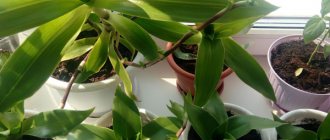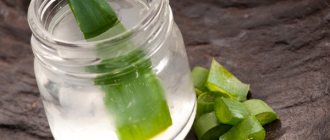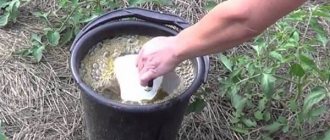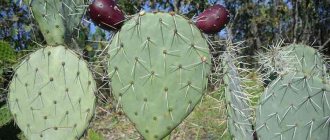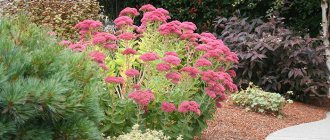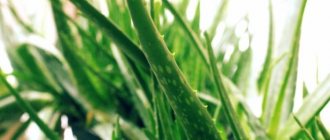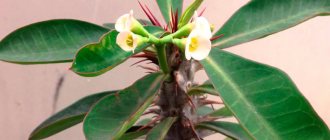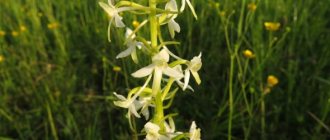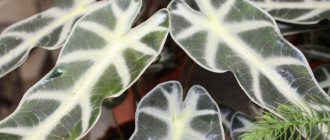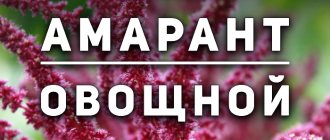The article was prepared by a specialist for informational purposes only. We urge you not to self-medicate. When the first symptoms appear, consult a doctor.
Purslane is an annual plant distinguished by fleshy, opposite, oblong, thick leaves and branched, recumbent, sometimes ascending and erect stems. Small yellow flowers are collected in bunches. The fruit is spherical or ovoid; dark brown seeds ripen in it. The plant blooms from June to September. Purslane lives in fallow lands, wastelands, and river valleys. Its habitat is Russia, the North Caucasus. Purslane is grown by gardeners as a vegetable.
This annual plant is found in abundance in garden plots and wastelands in southern Russia. The tradition of using purslane as a medicinal plant dates back to the times of Hippocrates and Pliny. These great healers recommended its use to the elderly and debilitated, as well as to those recovering from a serious injury. Arabic poetry of the Middle Ages praised purslane, calling it a “blessed herb” for its unique medicinal properties.
Purslane is widespread in Central Europe, Asia, and Mediterranean countries. It is found in fields, lawns and garden beds. Professional agronomists and home gardeners usually consider purslane a weed. Undeservedly and mistakenly, they try to get rid of it in every possible way. The study of purslane has opened up many possibilities for its use for medicinal and culinary purposes.
Snake and insect bites, sleep disorders and vitamin deficiencies, intestinal disorders and liver diseases - the wide range of uses of purslane as a healing agent has made it a very important crop. Purslane was not neglected in Russia either - in the diet of the inhabitants of monasteries it was used as a means to reduce potency, and also promoted the healing of wounds and relieved inflammation. In addition, it turned out that purslane also has culinary benefits. Its sour-tart taste still complements the bouquet of some dishes of French and Armenian cuisine. Purslane is used in salads and hot dishes; pickles and marinades are prepared from it, which are in no way inferior to delicious capers.
Purslane
- Pickled purslane
Useful properties of purslane
The medicinal properties of purslane have been used since ancient times; Hippocrates recommended this plant for many diseases. Its beneficial properties are truly limitless. Juicy greens contain vitamins of group A, which combine substances with common biological effects. The plant contains vitamins B, K, PP, and E.
Thanks to the organic acids present in the plant, normal metabolic processes in the body are maintained. The use of a medicinal plant helps to saturate organs and systems with salts of calcium, potassium, magnesium, etc. The leaves contain vitamin C, carotene, and flavonoids. Purslane is an excellent supplier of mucous and resinous substances.
In medicine, purslane has found use in relieving headaches, coughs, arthritis, and in treating problems of the gastrointestinal tract, liver, and shortness of breath.
Purslane-based products are prescribed for:
- Muscle relaxation.
- Softening and healing of skin with psoriasis, weeping wounds.
- Gentle bowel cleansing.
- Relieving symptoms of inflammation.
- Improvement of the myocardium.
- Diuretic effect.
- Detoxification after insect and snake bites.
- Improvement of the oral cavity for stomatitis, periodontal disease, sore throat.
Recent research by scientists has proven that purslane has a therapeutic effect in psoriasis, and also restores bone density in osteoporosis.
Studying the composition of purslane yielded unexpected results. It turned out that the nutritional value of the plant is not inferior to the main vegetables that we are used to seeing on the table. Purslane contains a high concentration of vitamin C, beta-carotene, and alpha-linolenic acid [1].
Nutrient and antioxidant compounds explain the high energy value of this seemingly unremarkable plant [2].
The concentration of nutrients and the medicinal properties of purslane are influenced by the growing conditions, variety and harvesting period of the plant [3].
In traditional Chinese medicine, purslane is used in the complex treatment of diabetes and hypertension. No special studies have been conducted on the antidiabetic effectiveness of purslane, but this has not in any way affected its popularity among people with diabetes. However, laboratory experiments were carried out with the participation of animals. One of them revealed that raw purslane polysaccharides can have a hypoglycemic effect in sick rodents [4].
Rich in vitamin A. Purslane has a strong antioxidant effect due to its high level of vitamin A. Its level in purslane is the highest among all green leafy vegetables. This vitamin compound has a positive effect on vision, heals mucous membranes, and protects the oral cavity and lungs from oncological processes.
Purslane contains high concentrations of vitamin C, B vitamins (riboflavin, niacin, pyridoxine), magnesium, calcium, phosphorus and iron.
Source of Omega-3. Purslane has long been considered one of the best sources of plant-based omega-3 fatty acids. Its active components can influence the level of total cholesterol and triglycerides. Along with reducing “bad” cholesterol, purslane increases the levels of “good” cholesterol - high-density lipoproteins.
The ability of omega-3 acids to reduce blood viscosity is known, which is very important in the presence of problems with blood vessels. Regular fish oil contains a certain amount of cholesterol and calories. Purslane is completely free of cholesterol, and 100 g of fresh greens contains only 20 calories.
Among all types of purslane, green, golden, and large-leaved golden are distinguished. Each of the plant varieties contains plant omega-3 acids and prevents the development of heart disease and various types of cancer [5].
To obtain maximum benefits in the form of sufficient amounts of omega-3 acids and minerals, purslane is consumed like green leafy vegetables [6].
Plant fatty acids are an essential component necessary for the synthesis of hormones. With their help, the body is protected throughout its life from malignant tissue degeneration, heart and vascular diseases, and chronic inflammatory processes. A number of enzymes present in omega-3s help maintain nutrient homeostasis in tissues.
Compared to spinach, purslane contains several times more valuable amino acids, vitamins, and ascorbic acid. It is superior to flaxseed oil in terms of the level of valuable fatty acids.
Chemical composition
Calories 16 Kcal
- Fat:
0.1 g - Proteins:
1.3 g - Carbohydrates:
3.4 g - Water:
93.8 g - Ash:
1.4 g - Fiber:
n/a
| Vitamins and fats | Quantity | % RDN |
| Omega-3 | 900 mg | 82% |
| Vitamin A (retinol) | 396 mcg | 44% |
| Vitamin C (ascorbic acid) | 21 mg | 23% |
| Vitamin B2 (riboflavin) | 0.112 mg | 9% |
| Vitamin B6 (pyridoxine) | 0.073 mg | 6% |
| Vitamin B1 (thiamine) | 0.047 mg | 4% |
| Vitamin B3 (PP, niacin) | 0.480 mg | 3% |
| Vitamin B9 (folic acid) | 12 mcg | 3% |
| Minerals (per 100 g): | Quantity | %RDN |
| Iron | 1.99 mg | 25% |
| Magnesium | 68 mg | 17% |
| Manganese | 0.30 mg | 13% |
| Copper | 0.11 mg | 13% |
| Calcium | 65 mg | 7% |
| Phosphorus | 44 mg | 6% |
| Selenium | 0.9 mg | 2% |
[Video] Purslane - food, healer, hormone of happiness and joy:
Interesting Facts
In addition to the main name - purslane (Portulaca, lat.), which means “collar”, some additional names have been assigned to the flower:
- chicken leg;
- rogue weed;
- midday heat;
- dandur;
- sandwich
Each of them reflects some characteristics of the plant, and each has its own story. In particular, Arabs in the Middle Ages found the plant “blessed,” and in the time of Hippocrates it was used as a medicine to help with toxic snake bites and insomnia. Whereas in certain countries where it grows, the plant is considered a weed.
In general, the genus Portulaca includes almost two hundred species of annual and perennial herbaceous plants. Almost one hundred of them belong to decorative plants. Nevertheless, in temperate latitudes, only two such species are cultivated - purslane flowers of decorative type and vegetable flowers. The latter is revered for its healing properties, and is also widely used in cosmetology and cooking.
Medicinal properties of garden purslane
Although there are several varieties of purslane, purslane is used for medicinal purposes.
Its characteristic species characteristics:
- Juicy small fleshy leaves of a rounded-oblong shape;
- Succulent stems of a reddish hue, creeping along the ground;
- Small yellow flowers located in the axils of the leaves appear from June to August;
- Small black seeds ripen in spherical polyspermous capsules;
- Reproduction occurs by self-sowing.
The beneficial properties of this plant are due to its unique chemical composition.
Substances contained in purslane:
- Carotenoids (beta-carotene, lutein) are precursors of vitamin A;
- Carbohydrates (sucrose, glucose, galactose, fructose, maltose) are fuel for cells;
- Coumarins – prevention of thrombosis, anticoagulant;
- Organic acids (oxalic) – stimulation of metabolic processes;
- Flavonoids;
- Mineral salts (magnesium, calcium, potassium);
- Vitamins and antioxidants – normalization of blood clotting, activation of metabolic processes;
- Macro- and microelements.
The unique composition of purslane has provided it with a strong position in folk medicine as a remedy for the treatment of many diseases.
Therapeutic effects of purslane:
- Antioxidant,
- Diuretic,
- Antimicrobial,
- Antitoxic,
- Hypoglycemic,
- Antiulcer,
- Anti-inflammatory,
- Antihelminthic,
- Laxative,
- Regenerating.
All parts of the plant except the roots are used for medicinal purposes - flowers, stems, leaves, and seeds.
The use of purslane for the treatment of diseases:
- For neurodermatitis and psoriasis of the scalp, lotions with an infusion of the plant relieve itching, flaking and swelling;
- Cholesterol levels return to normal;
- Glucose levels are normalized;
- For cystitis and urethritis, the diuretic and anti-inflammatory properties of the plant appear;
- Infusion and decoction of plant parts is used for cholelithiasis and liver diseases;
- Cardiac activity is normalized;
- Inflammation of the gums is stopped, conjunctivitis is treated;
- Due to the properties of purslane to cause spasms of smooth muscles, it effectively treats helminthic infestations: ascariasis, hookworm, affecting the muscle tissue of parasites;
- Honey with crushed purslane seeds helps with asthma;
- You can get rid of warts by rubbing them with fresh plant juice;
- You can get rid of the consequences of a bee sting by applying a purslane leaf to the sore spot;
- The effect of purslane on the adrenal cortex stimulates the release of insulin and lowers blood sugar levels.
It is not difficult to prepare an infusion of purslane; for this you take 2 tbsp. l. chopped herbs and pour 1.5 cups of boiling water. After 60 - 90 minutes, filter the infusion and use it for oral administration. In order to prevent various diseases, we take 1–2 tablespoons of infusion, in advanced stages – 3–4 tablespoons.
Contraindications to the use of purslane:
- Pregnancy, lactation;
- Heart rhythm disturbances (bradycardia);
- Autonomic vascular disorders;
- Hyperexcitability of the central nervous system;
- High blood pressure.
Description
Purslane is a herbaceous annual with a spindle-shaped root. The creeping, outstretched stems are colored green with an admixture of purple. The rising branches rarely exceed 15 cm in height. All shoots are densely leafy. The lower leaves are located opposite, the upper ones are collected in a rosette. The leaf blades are fleshy, spatulate in shape with a rounded tip. The foliage color is dark green. The plant quickly forms turf mats.
Flowering begins with the arrival of summer and lasts until mid-autumn. Small flowers appear at the branching points of the stem and in the axils of the leaves. The flowers are yellow, white, sometimes with a brown tint.
After flowering, capsule fruits with multiple small black or dark gray seeds are formed.
Application of purslane
Purslane is a useful plant in all respects, it is used in folk medicine, it is excellent as a cosmetic product, and is also suitable for consumption. Juicy green shoots for preparing salads are cut before flowering begins. Purslane has a tart and spicy taste, similar to the taste of spinach and sorrel. The healing substances contained in the plant help treat diabetes, kidney, stomach and liver diseases. It is also useful for eliminating the causes of headaches.
The miracle herb relieves inflammation in the bladder, reduces pain from enterocolitis and hemorrhoids. Decoctions have antimicrobial effects and are therefore effective for conjunctivitis and dysentery. It has been established that the plant relieves dizziness, treats hypotension, and cleanses joints of accumulated toxins that contribute to arthritis. Treatment of ulcers and lichens with herbal decoctions permanently eliminates these unpleasant diseases.
Purslane lotions relieve itching and flaking in psoriasis and quickly heal festering wounds. The fresh juice of the plant can remove warts. It normalizes the functions of the heart muscle and is a hemostatic agent. It is used in the treatment of certain sexually transmitted diseases. The juice is squeezed from the above-ground part of the plant and taken 1 tablespoon 3 times a day before meals. Traditional medicine recommends infusions and decoctions of stems and leaves for gallstone disease, to reduce blood cholesterol and prevent the formation of atherosclerotic plaques.
Chemical composition
The leaves and stems contain vitamin C and carotene, 2.24% nitrogen substances, 0.4% fat, 1.03% fiber, 1.56% ash.
Active ingredients
The aerial part of the plant contains organic acids (malonic, succinic and citric), alkaloids, proteins, carbohydrates (glucose, galactose, fructose, sucrose, maltose and raffinose), carotene, saponins, phenol carboxylic acids (cinnamic, ferulic and sinapic acids), vitamins C , E, PP and K, dopamine, norepinephrine, mucous and resinous substances. Fatty oil was found in the seeds.
Purslane Recipes
There are many ways to prepare medicinal products from purslane, all of them are effective when used systematically:
- Recipe for purslane infusion No. 1: pour 1 tablespoon of dry raw material with 1 glass of boiling water, leave for 1 hour, strain. It is good to use this product for rubbing into the hair roots for dandruff.
- Recipe for purslane infusion No. 2: 40 g of fresh herb should be poured into 200 ml of water, left for 2 hours, squeezed and taken with the addition of two chicken egg whites throughout the day. Treatment should be carried out for seven consecutive days.
- Recipe for purslane decoction No. 1: boil 1 tablespoon of raw material for 10 minutes in 200 ml of water, then leave for 2 hours, strain. It is recommended to take the medicine 1-2 tablespoons 3 times a day.
- Recipe for purslane decoction No. 2: 1 tablespoon of crushed dry raw materials should be boiled in 1 glass of boiling water over low heat for 15 minutes, wrapped or poured into a thermos and left for 1.5 hours. Take 1 tablespoon of the decoction 3-4 times a day before meals for arthritis.
- Recipe for purslane decoction No. 3: 1 tablespoon of fresh herb should be boiled for 10 minutes. after the start of boiling, then leave, wrapped, for 2 hours, strain and take 1-2 tablespoons 3-4 times a day for arthritis.
Large-flowered purslane - Portulaca grandiflora Hook. (1829)
Purslane grandiflora
Typically, pubescent annual or perennial succulent herbs, Purslane grandiflora, have ascending or spreading stems. Flowers are bisexual, actinomorphic, 5(4-6) - dimensional, large, up to 2 cm in diameter, yellow, red, purple or orange, solitary or crowded, in the axils of stem leaves. The bracts are paired, usually surround the ovary like a calyx, fused at the base with the ovary, falling off with fruit. There are 5 (4-6) perianth parts, free or fused at the base. Stamens 8-15, free or fused at the base with the perianth. Ovary inferior or semiinferior, with numerous ovules; columns 3-6 separate. The fruit is a single-locular, multi-seeded capsule that opens with a transverse slit. Leaves with stipules, succulent, linear, valval, entire, arranged along the stem.
Distribution: South America; in culture in Europe, Asia and North America, sometimes runs wild.
Economic value: decorative.
Purslane in cooking
Purslane leaves are usually eaten, forgetting that the stem and flower buds are also edible. To prepare, use a sharp knife to cut off the juicy, green shoots at the very roots. In order to preserve all nutrients, the maximum permissible low temperatures and a short time are used. During boiling or frying, antioxidant compounds are destroyed. It is noteworthy that steaming preserves high concentrations of flavonoids, carotene and minerals.
Fresh green leaves of purslane are consumed as a salad or in the form of vegetable juice. Young greens are wonderful as an ingredient in nutritious salads. Fried, stewed purslane stems are prepared as a side dish for poultry and fish dishes.
Purslane has always been especially loved in the South Indian states. There are well-known Indian recipes for preparing purslane in combination with curries and vegetable soups, rice and finger millet pies. Many people like to mix and fry purslane with spinach and vegetables.
Pickled purslane
Liter jars are usually prepared for pickling. For one container you will need 2 bay leaves, from 2 to 4 cloves of garlic, depending on your taste preferences. The marinade is prepared based on 1 liter of water - add 20 g of salt and 20 ml of table vinegar to it.
Purslane greens are thoroughly washed, roots and dry leaves are removed and placed in a saucepan with boiling water and blanched for up to 5 minutes. The greens prepared in this way are placed in a sieve or colander to allow the water to drain completely. During this same time, the purslane has time to cool down. After this, the stems are cut into 5-6 centimeters.
Place bay leaves and garlic in clean jars, and place purslane on top. To enhance the taste and add spiciness, you can add a piece of hot red pepper or a pea of bitter black pepper. The chopped shoots are compacted tightly and poured with marinade prepared in advance. The jars are sterilized over low heat in a pan of boiling water, then rolled up with sterile lids.
[Video] Recipe for pickled purslane:
Vegetable salad with purslane
If you want to enrich your diet or surprise your guests, prepare a salad of vegetables and purslane. To prepare a nutritious and healthy dish you will need:
- 300-400 grams of purslane leaves, separated from the stems.
- 100 grams of canned corn.
- 100 grams of red onion, cut into thin rings.
- 2 eggs.
- 1 large tomato.
- Salt and pepper to taste. Instead of regular table salt, you can use sea salt.
- 2 tablespoons of any vegetable oil (nut, olive, sunflower, flaxseed).
Purslane leaves are thoroughly washed, dried with a towel, and large ones are cut. Hard-boiled eggs are chopped with a knife, the onion is cut into thin rings, the tomato is cut into large pieces or slices. All ingredients are mixed in a salad bowl. Add salt and pepper to taste. The finished salad is seasoned with vegetable oil and served immediately.
[Video] Purslane salad recipe:
Vegetable purslane pesto
To diversify the taste of your usual pasta, you can use pesto sauce based on vegetable purslane. To do this you should prepare:
- 450 g of young shoots and stems of purslane.
- 2 cloves of garlic.
- 50-70 g grated parmesan.
- 100 ml olive oil.
- 30 g roasted almonds.
Purslane is washed and dried with a towel. The greens along with garlic, grated Parmesan, and almonds are poured into a blender or food processor. In the selected device, all components are thoroughly crushed and mixed until smooth. After this, olive oil is poured into the mixture and stirred again for about a minute.
The finished pesto is transferred to a glass container and stored tightly closed in the refrigerator for no more than 14 days. Purslane pesto can be used as a spread on sandwiches, added to pureed soup, and vegetable dishes.
[Video] Awesome purslane! Prepare it like this:
What it looks like and where it grows
Purslane is an annual succulent. Its root system is taprooted, the main root grows into the ground to a depth of at least 20 cm, it is stocky, juicy, and several lateral ones branch off from it. Despite its external strength, the root is quite brittle, and the upper, above-ground part can easily come off. Since this plant is quite life-loving, almost after a day and a half the broken off part is already growing with new roots to the soil.
The stem of this herb is reddish in color and can reach a length of 10 to 30 or even 40 cm, and it is so smooth that it seems slightly polished. The stem branches from the very base and usually lies on the surface of the soil, therefore it is called recumbent. Its tops reach towards the sun and therefore rise upward.
The leaves of the plant are without petioles; they are located directly on the stem; botanists classify them as sessile. Like all succulents, each leaf is succulent and fleshy, and is either simple oval, ovoid, or spatulate in shape. On the lower part of the stem, the leaves are attached alternately in a spiral, the upper ones - in pairs opposite each other.
Inconspicuous yellow small flowers are collected two or three in small bunches, sitting in inconspicuous places - either at the attachment points of the leaves - in the axils, or in places where the stem branches. The flowering period of purslane is from June to August.
After flowering ends, the plant forms fruits - small round or ovoid boxes no more than a centimeter in diameter, inside of which there are many small shiny black seeds. The boxes open with a crack across, in different directions - like small gates. This is where the name of the plant comes from, because “portula” translated from Latin means “small gate”. Botanists gave the entire fruit itself the name “little fruit”. The fruits ripen in early autumn.
In the wild, purslane grows in warm regions of the Earth's Northern Hemisphere. Some scientists are sure that his homeland is India, and from there he went to settle in other countries. In warm climates, purslane can grow from one root for several years, as it is a perennial. In the middle zone, it sharply slows down its growth when the air temperature drops in autumn, and it cannot withstand winter frosts categorically and does not survive even under additional shelter, which is why it is considered an annual, growing annually from seeds.
Purslane is photophilous, loves sunny, but at the same time humid places. Prefers sandy soil. It is easy to find along streams and rivers, around ponds and quarries; gardeners have probably encountered it in their plots and gardens. And many summer residents, who know about the beneficial properties of purslane, specially cultivate it on their site, planting it in sunny beds with well-drained soil rich in organic matter. After cutting green shoots, new ones grow back quite quickly, so in one summer season it is quite possible to get up to six to seven harvests of green mass.
Collection and storage
Traditional healers use the green, above-ground part of the plant. It is collected during flowering; it is during this period that purslane is richest in useful substances.
You can cut shoots close to the ground, but only take young and elastic branches for harvesting. Old shoots begin to rot quickly during drying.
Since purslane stems mostly lie on the ground, they are dirty and dusty; after cutting, they must be washed with running water: first with warm water, then lower the temperature and bring it to cool. After washing, lay the greens on a towel to let the water drain, and then tie them into small bunches and hang them outside, in the shade, so that they don’t get rained on if it suddenly starts to rain.
After drying, place the purslane in cotton bags and store in a dry and cool place. In such conditions, it does not lose its beneficial properties for a year and a half.
The seeds of the medicinal plant are harvested towards the end of September, when they are already ripe. The grass is mowed, threshed, and the seeds are dried in household dryers, the temperature is set no higher than 50 degrees. If the autumn is warm, the weather is sunny, you can dry the seeds in the fresh air - where they will not be exposed to direct sunlight. The seeds retain their beneficial qualities longer than the grass - up to two years.
- To use purslane for culinary purposes, it is prepared either by pickling or pickling.
- To marinate, the collected herbs are washed and dipped in boiling water for 5 minutes. After this, it is placed in glass jars. For the marinade, pour 2 tablespoons of salt, a spoonful of sugar and spices into a liter of water - pepper, parsley, dill, bay leaf, garlic, basil. Pour a large spoonful of vinegar into the boiled mixture, immediately pour it into jars with purslane and seal them with hermetically sealed lids.
- For salting, you can use either the brine method or the dry method.
- For the brine method, the washed purslane is cut into pieces, boiled until soft and placed in jars. The brine is prepared at the rate of half a tablespoon of salt per glass of water. The mixture is boiled, purslane is poured over it and the lids are rolled up.
- For dry salting, cut 1 kg of the plant and mix it with 200 g of salt until it dissolves. Place the greens in jars and cover them with plastic lids and store them in the cellar. Before use, it is better to rinse it to remove excess salt.
Planting and caring for purslane
The grass is grown as a vegetable and medicinal plant; it is an excellent decoration for any garden. Purslane is a heat-loving plant and can easily tolerate drought.
Growing purslane from seeds is a real pleasure; all seeds provide excellent germination and no special soil care is required. In order to obtain seedlings, seeds are sown in April. The grass prefers moderate watering. It also propagates by cuttings. To do this, the mother plants are transferred indoors for the winter, the shoots are cut off in the spring and planted in loose sandy loam soil.
In regions with short summers and cool climates, it is grown through seedlings or sowing in the ground.
Purslane is sowed at a time when there is no longer any fear of return frosts, on light soils and in a sunny place. Seeds are sown in rows to a depth of about 1 cm, embedded in the soil. The distance between rows is 50 cm. Shoots with 2 leaves are thinned out, leaving 1 plant at a distance of 10 cm.
Further care for purslane seedlings:
- Regular watering
- Loosening row spacing,
- Weeding,
- Fertilizing with complete mineral fertilizer.
Growing purslane through seedlings will speed up its ripening time. Seeds are sown in containers in late March - early April. Watering and fertilizing seedlings is similar to caring for purslane in open ground. The seedlings are ready for planting in open ground 25 days after germination. Return frosts by this time should no longer threaten the plants.
Purslane shoots are cut 3 weeks after germination in open ground or 10 days after planting seedlings. From the same plant you can make 3 cuttings of shoots per season. It is advisable to prevent vegetable purslane from flowering to use it for medicinal or culinary purposes, as the plant acquires a sharp pungent taste and its leaves become hard.
[Video] Purslane from sowing to flowering:
Growing seedlings
Dandur seeds are very hardy, because the plant practically does not get sick, it contains many bactericidal elements that protect it from rot and viruses. Therefore, it is not advisable to disinfect seeds. Seed stratification is also not needed, because all purslanes are heat-loving plants; cold stress only reduces the number of sprouted seeds.
Lemon balm - growing from seeds in the country
Sow seeds in mini-greenhouses on the surface of moist, fertile, compacted soil. The seeds are only slightly pressed into the ground, but not covered with soil. The greenhouse is covered with a transparent cover and transferred to a warm place, protected from direct sunlight.
Important! Periodically, the greenhouse is opened and ventilated, the seeds are moistened from a spray bottle with fine or mist-like sprays.
After germination, the greenhouse is moved closer to the light. In order to prevent the seedlings from stretching out, it is necessary to create conditions under which they will be exposed to light for at least 14 hours every day. After the formation of 3-4 true leaves, the seedlings are planted in other planting containers. Bushes with 8-10 leaves are planted in a garden bed in open ground.
Vegetable purslane quickly runs wild. Uncontrolled ripening and self-seeding of seeds can lead to the need to solve the problem of how to get rid of purslane in the garden forever.
Purslane is so undemanding to the soil that it will grow between slabs
How to remove purslane from the garden?
Wild purslane is capable of filling the entire space of a personal plot with its shoots, leaving no chance for cultivated plants to fully develop. One gram of seeds of this annual contains more than 3 thousand pieces. The exceptional germination power of the seeds of this plant requires the use of special measures to protect against it. To prevent purslane seeds from germinating for another 10 years in a row, special measures must be taken to neutralize them.
Mechanical measures to control purslane seedlings:
- Deep digging of the soil - carried out in early spring or late autumn, when the seeds fall deep into the soil and have no chance of sprouting.
- Mulching seedlings - adding a layer of mulch from bark, straw, fallen leaves, mown grass under the roots of cultivated plants, as well as covering the soil with black film or covering material.
- Regular weeding is carried out manually from April several times during the growing season.
Removed weeds should be disposed of in a compost heap or burned after drying.
The chemical method of controlling purslane in beds is to treat the soil after germination with systemic herbicides. Their choice depends on what is sown in the garden bed; for each type of vegetable, a certain herbicide is suitable that destroys weed seeds and does not affect the health of cultivated plants. For example, when planting carrots or onions, you can use the herbicide “Stomp”, and “Zenkor” is suitable for potatoes.
Purslane should be destroyed after it is removed from the soil. The collected weed must be treated with herbicides “Tornado”, “Napalm” or similar substances.
Unpretentious and hardy purslane is a real “pharmacy in the garden.” The main thing is to choose the right variety of this plant for cultivation. Growing vegetable purslane will provide raw materials for the preparation of medicines for the treatment of many diseases.
Contraindications to the use of purslane
Purslane is contraindicated in hypertension
(purslane contains components that can provoke a sharp rise in pressure, up to a hypertensive crisis!) and low heart rate, as well as in patients with a tendency to autonomic disorders and seizures. Therefore, purslane in any form is contraindicated in patients with epilepsy. Purslane-based products can cause seizures.
Purslane herb stimulates the release of insulin and causes hypoglycemia, vasospasm, and increases blood pressure.
Pregnant and breastfeeding women should also not try purslane dishes. Active phytoelements affect the muscular wall of the uterus and cause hypertonicity, which can be extremely dangerous.
Additionally, like many leafy green vegetables, purslane contains oxalic acid. This substance tends to crystallize and be deposited in the kidneys in the form of oxalates. In 100 g of fresh purslane, oxalic acid accounts for 1.31 grams - this is more than in spinach (0.97 g). To prevent problems with the urinary system, it is recommended to drink enough water.
Although purslane is used in the treatment of diabetes, it is important to remember that excessive insulin production can cause hypoglycemia.
Diseases and pests
Purslane is considered the most pest-resistant plant. But due to an excess of moisture in the soil, it can be affected by a fungal disease - rot. The leaves become covered with dark spots, the stems are affected, and both the aboveground part of the plant and the root system rot. Purslane stops growing and developing and does not bloom. In order to cure a plant, you need to get rid of all its rotten parts, treat healthy stems and leaves, as well as all the soil in the garden bed with fungicide solutions.
Despite the fact that pests bypass purslane, insects such as aphids or thrips may appear on it. Aphids are easy to see with the naked eye. It feeds on plant sap and multiplies quickly. If you fight it, then soon the plant will be completely overrun by its colony. In order to get rid of aphids, purslane must be thoroughly treated with a solution of an insecticide diluted in water in the proportion specified in the instructions for the drug.
Thrips can be seen on the plant due to the silvery stripes and flecks on both the stems and leaves of the purslane plant. The insect is so small in size that it is almost impossible to see it with the naked eye. To combat this pest, use a solution of a systemic insecticide (fitoverm, karbofos, etc.).
